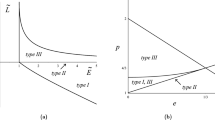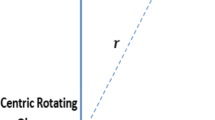Abstract
If an axially symmetric stationary metric is given in standard form (i.e. in coordinates adapted to the symmetries) the transformationφ→φ′ =φ-ωt (ω=constant) of the azimuthal angle leads to another such standard form. The spatial latticeL′ corresponding to the latter rotates at angular velocityω relative to the latticeL of the former. For the standard form of a stationary metric there are simple formulae giving the four-acceleration of a given lattice point and the rotation of a gyroscope at a given lattice point. Applying these formulae toL′, we find the condition for circular paths about the axis inL to be 4-geodesic, and also the precession of gyroscopes along circular paths which are not necessarily geodesic. Among other examples we re-obtain the complete geodesic structure of the Gödel universe, and the gyroscopic precessions associated with the names of Thomas, Fokker and de Sitter, and Schiff.
Similar content being viewed by others
References
Landau, L. D., and Lifshitz, E. M. (1971).The Classical Theory of Fields, (Pergamon Press, Oxford/Addison-Wesley, New York) 3rd. ed.
Kramer, D., Stephani, H., MacCallum, M. A. H., and Herlt, E. (1980).Exact Solutions of Einstein's Field Equations (Cambridge University Press, Cambridge)
Rosenblum, A. (1987).Nuovo Cimento C,10, 645.
Hawking, S. W., and Ellis, G. F. R. (1973).The Large Scale Structure of Space-Time (Cambridge University Press, Cambridge)
Thomas, L. H. (1926).Nature,117, 514; (1927).Phil. Mag.,3, 1.
Fokker, A. D. (1920).Kon. Akad. Weten. Amsterdam, Proc.,23, 729.
de Sitter, W. (1920).Mon. Not. Roy. Astron. Soc.,77, 155, 481.
Rindler, W. (1977).Essential Relativity, (Springer-Verlag, Berlin) 2nd. ed.
Schiff, L. I. (1960).Phys. Rev. Lett.,4, 215; (1960).Proc. Nat. Acad. Sci.,46, 871.
Synge, J. L., and Schild, A. (1949).Tensor Calculus, (University of Toronto Press, Toronto).
Shapiro, I. I., Reasenberg, R. D., Chandler, J. F., and Babcock, R. W. (1988).Phys. Rev. Lett.,61, 2643.
Author information
Authors and Affiliations
Rights and permissions
About this article
Cite this article
Rindler, W., Perlick, V. Rotating coordinates as tools for calculating circular geodesics and gyroscopic precession. Gen Relat Gravit 22, 1067–1081 (1990). https://doi.org/10.1007/BF00757816
Received:
Issue Date:
DOI: https://doi.org/10.1007/BF00757816




